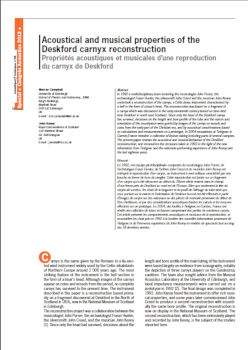In 1992 a multidisciplinary team including the musicologist John Purser, the archaeologist Fraser Hunter, the silversmith John Creed and the musician John Kenny undertook a reconstruction of the carnyx, a Celtic brass instrument characterised by a bell in the form of a boar’s head. The reconstruction was based on a fragment of a carnyx which was discovered in the early nineteenth century buried on farm land near Deskford in north-east Scotland. Since only the head of the Deskford carnyx has survived, decisions on the length and bore profile of the tube and the nature and orientation of the mouthpiece were guided by images of the carnyx on vessels and coins from the early part of the Christian era, and by acoustical considerations based on calculations and measurements on a prototype. In 2004 excavations at Tintignac in Correze,France revealed a collection of bronze tubing including parts of several carnyxes. The present paper reviews the acoustical and musical behaviour of the Deskford reconstruction, and reconsiders the decisions taken in 1992 in the light of the new information from Tintignac and the extensive performing experience of John Kenny over the last eighteen years. En 1992, une équipe pluridisciplinaire composée du musicologue John Purser, de l’archéologue Fraser Hunter, de l’orfèvre John Creed et du musicien John Kenny ont entrepris la reproduction d’un carynx, un instrument à vent celtique caractérisé par une bouche en forme de hure de sanglier. Cette reproduction est basée sur un fragment d’un carynx qui a été découvert au début du 19eme siècle enterré dans le champ d’une ferme près de Deskford au nord est de l’Écosse. Bien que seulement la tête du carynx ait survécu, les choix de la longueur et du profil de l’alésage du tube ainsi que ceux portant sur la nature et l’orientation de l’embout buccal ont été effectués à partir d’images de carynx sur des vaisseaux ou des pièces de monnaie provenant du début de l’ère chrétienne, et par des considérations acoustiques basées les calculs et les mesures effectués sur un prototype. En 2004, des fouilles à Tintignac en Corrèze, France ont révélé une collection de tubes en bronze comprenant des parties de nombreux carynx. Cet article présente les comportements acoustiques et musicaux de la reproduction, et reconsidère les choix pris en 1992 à la lumière des nouvelles informations provenant de Tintignac et de l’immense expérience de John Kenny en matière de spectacle tout au long des 18 dernières années.


